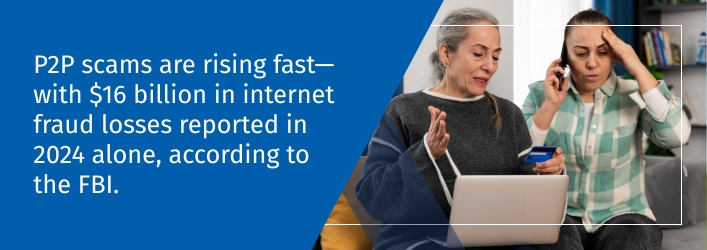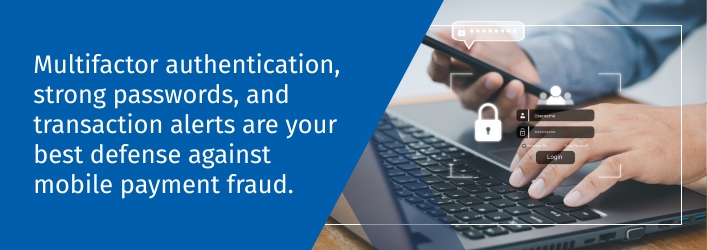How to Avoid Peer-To-Peer Payment Fraud
Peer-to-peer payment (P2P) scams are on the rise, along with many other types of fraud. P2P apps and mobile banking are increasingly popular because they offer convenient ways to make payments and send funds. Unfortunately, they also give thieves a chance to make off with your hard-earned money.
P2P payments are typically made through a smartphone app, such as PayPal, Venmo, Zelle, and Cash App. They make it easy for people to shop, split dinner bills, and send money to friends and relatives without using cash or checks. P2P payments are typically processed within minutes and can’t be canceled or reversed, which makes recovering stolen funds extremely difficult.
We offer this information on mobile payment fraud prevention to teach you how to avoid P2P scams and conduct all your transactions as safely as possible.

P2P Payment Scams and Fraud Are on the Rise
Internet crimes, including P2P fraud, amounted to $16 billion in reported losses in 2024, according to the FBI’s 2024 Internet Crime Report. This was a 33% increase in losses from the year before. A report by JD Power in 2023 revealed that the most common types of financial fraud were unauthorized purchases on a credit card (9%), a debit card (9%), and using a P2P payment app to conduct fraud (8%).
What Are Some Examples of P2P Scams?
Zelle fraud, Venmo scams, and Cash App fraud hit thousands of Americans each year, and their numbers are expected to rise. As the use of P2P payment apps increases, so will the number of thieves looking to use them to rip people off. P2P payments are handled nearly as fast as cash, which makes tracking down criminals and recovering funds extremely difficult. That’s why it’s so important to avoid getting scammed in the first place and it’s why we offer these steps to avoid mobile banking fraud.
This happens when scammers send a message to someone saying they “accidentally” transferred money to them using a P2P app. To the victim, it appears that someone sent money to their account.
Criminals ask the victim to send the money back right away. The victim transfers funds, not realizing the scammer’s transfer was made from a fraudulent account, used stolen funds, or a stolen credit card. The criminal’s transfer to the victim, using stolen funds, is blocked by the payment service and doesn’t go through. The victim, being a legitimate user, sees their transfer go right through to the criminal, leaving the victim high and dry.

A scammer impersonates a legitimate business, such as a P2P service or a bank, and claims to be a member of their fraud department. The scammer tells the victim that there is suspicious activity on their account and the victim needs to transfer money to verify that their account is legit and working properly, but the funds are sent to an account controlled by the fraudsters. Sometimes a scammer tells a victim that the victim is really transferring money to their account, when in reality the victim is sending money to the scammer.
Another tactic is when a scammer asks the victim to confirm information such as the usernames and passwords for their bank account, credit card, etc. A scammer might also ask the victim to “verify” their Social Security number. A victim might be directed to a fake webpage to enter their password or some other personal information that the thieves use to rip them off. The scammers will change the victim’s password and other settings, then transfer money to themselves. If they gain a victim’s Social Security number, they’ll use it for identity theft.
Criminals pose as legitimate sellers on eBay, Etsy, or some other platform, claiming to sell popular products, which may be at a lower price than legitimate merchants offering the same items. The seller requests payment by a P2P app, but the products never arrive, and the thieves disappear with the money
This is a reverse approach to the fake seller scam. With a fraudulent payment scam, criminals link a stolen credit card number to a payment app and makes purchases online. The victim ships the items, but soon discovers the payment was fraudulent and the funds are removed from their account. The seller winds up losing both the merchandise and the payment itself.
With artificial intelligence (AI) scammers can impersonate just about anyone and clone their voice, their face, and even create fake videos using someone else’s identity. With an impersonation scam, a criminal pretends to be someone the victim knows, such as a friend or family member, and tells the victim they need money for an emergency. This scam relies on using a sense of urgency and emotions to get the victim to send money before they have a chance to think about the request or to verify if it’s legit.
This is a variation on the infamous “Nigerian prince” email scams that were prevalent years ago. This scam takes a similar approach. The scammer reaches out to a victim and asks for money to help them recover lost funds, file a legal claim, etc. The scammer promises the victim that they’ll receive a large financial reward in exchange for their help.
A criminal sends a message via text or email to trick their victims into installing malware on their device that records their P2P transactions and credentials that they can use to access the victim’s bank account. The phishing scam might start off by claiming the victim has a missing package and telling them to tap on a link to track its whereabouts. Another approach involves a scammer telling a victim that they need to install an app to protect their device, or to verify an account by tapping on a link. The link turns out to be bogus and is just a way for scammers to trick victims to install spyware, give a scammer access to their device, or reveal their logon credentials for their bank or a P2P service.
A stranger asks to borrow your phone, claiming some type of emergency. The only “help” the scammer wants is to use your device to send money to themselves.
How to Stop P2P Fraud before It Happens
One of the primary tools that scammers use is to create a sense of urgency. They want a victim to think an account has been compromised or a friend or relative desperately needs money in a hurry. If someone claims to represent a legitimate business or law enforcement, write down their contact information and take the time to find a legitimate number online. You can call that number directly to verify if the person who contacted you is legit.
Always Verify
If someone pretending to be a friend or relative reaches out to you, try asking the caller questions that only the real person would know. You might ask when the last time you saw each other was, what you talked about, what meal you shared, etc. You could ask them to relate a favorite joke or story. You could also reach out to another friend or family member to see if they know what’s going on and to verify if the request is legit.
Take Your Time
Don’t pay anything or send any funds until you know for sure that a request is safe. Keep in mind that your bank or a P2P app would never ask you to send money to someone just to “verify” that your account is working. If someone wants you to make a rushed decision, don’t fall for it. Take the time to think about what you’re doing and don’t send anyone a penny, or reveal confidential information, until you confirm that someone is for real.
Be Suspicious
If you’re shopping online, check an account holder’s history to make sure they aren’t some fly-by-night operation that’s only been around for a couple of days. If an offer seems too good to be true, that just might be the case. Don’t use a P2P service to send money to people or businesses you don’t know.
Use Multifactor Authentication
Set up multifactor authentication on all your accounts. You can do this using a multifactor authentication app, or by having a text message or email sent to you anytime someone tries to log on to your account. This offers an extra layer of protection against someone hacking into your account, even if they have your password.

Update Your Contact List
Store contact information on your phone for your bank, credit cards, and customer service for any P2P apps that you use. This way, it’ll be easy for you to reach out to them in case of fraud or if you’re contacted by someone who claims to represent the company.
Other Key Tips on Avoiding Mobile Banking Fraud and P2P Scams:
- Only call your bank from a legitimate number, such as on the back of your ATM card, your bank statement.
- Take a close look at any text messages you receive from your bank. Most financial institutions will only text you from a five-digit number, rather than a full telephone number.
- Set up alerts on all your financial accounts to notify you of transactions on your account, or any transaction above a particular limit.
- Keep your P2P software app updated on your phone, as well as your phone’s security systems.
- Avoid using P2P, banking, and other secure apps on public Wi-Fi networks or mobile hotspots. Thieves could intercept your transmission and use it to steal your payment info.
- Don’t share your account numbers, passwords, or personal information with anyone who unexpectedly contacts you.
- Use a password, PIN, or some other way of locking and unlocking your phone to keep it secure. If someone gained access to it, they could use it to drain your accounts.
- Don’t let strangers borrow your phone.
How to Respond to a P2P Payment Scam
If you suspect or have evidence that you’re the victim of P2P payment fraud, contact all the financial institutions involved, such as the P2P service, your credit card, and your bank. You can also file a complaint online with the FBI’s Internet Crime Complaint Center or the FBI’s Oklahoma City office at (405) 290-7770. You could also file a complaint with the Federal Trade Commission (FTC) and contact the Oklahoma Attorney General’s office’s Consumer Protection Unit.
How Vision Bank Protects Customers
We offer several ways to keep your accounts this includes:
• Making it easy to report lost and stolen credit cards or debit cards.
• Encryption technology and timeout features for online banking.
• Multifactor authentication.
• Callbacks on wire transfers, to verify legitimacy.
• Checking IDs for in person banking.
• Card control and card processing features through our mobile app and digital banking.
Contact Us to Learn More about P2P and Online Banking Security
We’re here to help you avoid getting scammed. If you’d like to learn more about our secure banking services, please contact us or visit one of our many South-Central Oklahoma locations. You can also check out our blog for the latest news on financial security and how to avoid getting scammed.

